Abstract
The structure of the staphylococcal nuclease (EC 3.1.4.7)—thymidine 3′,5′-bisphosphate—Ca2+ (enzyme—inhibitor) complex has been extended to 1.5-Å resolution by using much additional data and a phase refinement scheme based on an electron-density map modification procedure. By correlating this structure with the known properties of the enzyme, a mechanism of action is proposed that involves nucleophilic attack on phosphorus by a water molecule, which is bound to Glu-43, in line with the 5′-CH2O(H) leaving group. The carboxylate of Glu-43 promotes this attack by acting as a general base for the abstraction of a proton from the attacking water molecule. Nucleophilic attack is further facilitated by polarization of the phosphodiester by an ionic interaction between a Ca2+ ion and a phosphate oxygen atom and by four hydrogen bonds to phosphate oxygen atoms from guanidinium ions of Arg-35 and Arg-87. These interactions may also catalyze the reaction by lowering the energy of a trigonal bipyramidal transition state. The hydrolysis of nucleic acid substrate proceeds by cleavage of the 5′—P—O bond to yield a free 5′-hydroxyl group and a terminal, 3′-phosphate monoester group. In the inhibitor complex the only general acid group found in a position to donate a proton to the leaving 5′-oxygen is the guanidinium ion of Arg-87. Alternative proton donors, presently lacking direct structural support, could be the phenolic hydroxyl group of Tyr-113 or a water molecule. The precision and rigidity of the location of the reactants at the active site and the probable dual binding and catalytic roles of the guanidinium ions of Arg-35 and Arg-87 are especially noteworthy.
Keywords: micrococcal nuclease, arginine residues, x-ray crystallography
Full text
PDF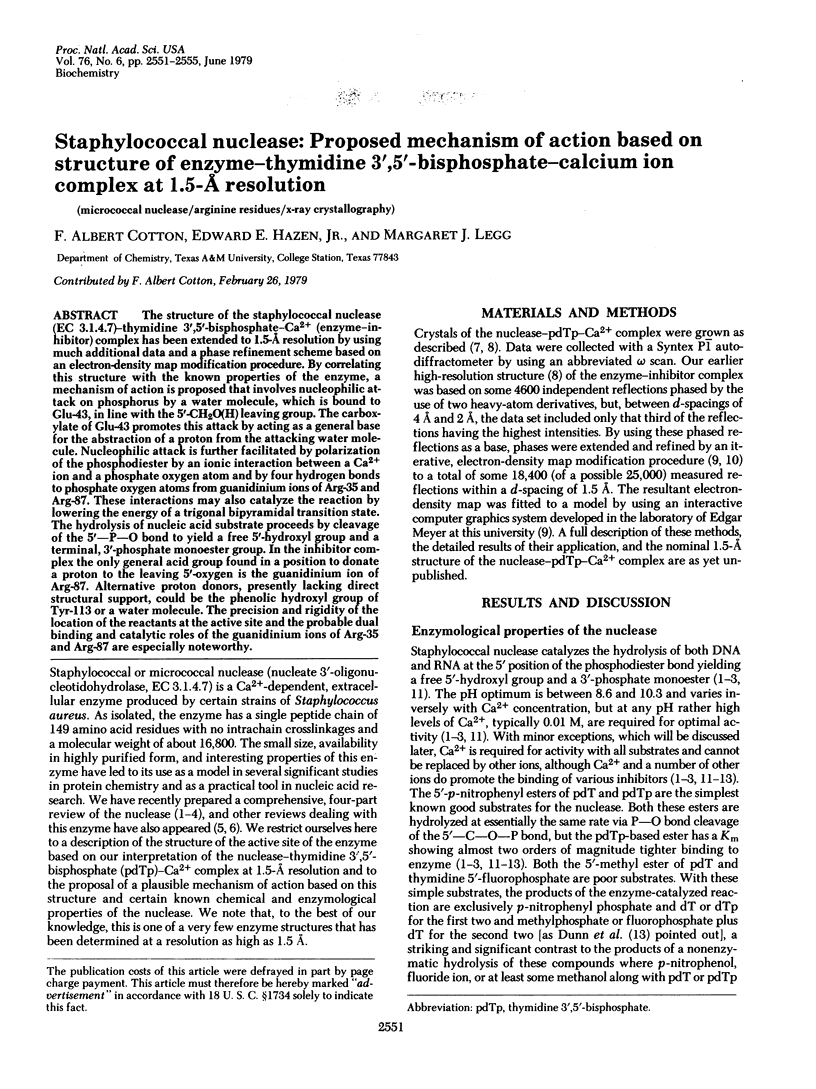
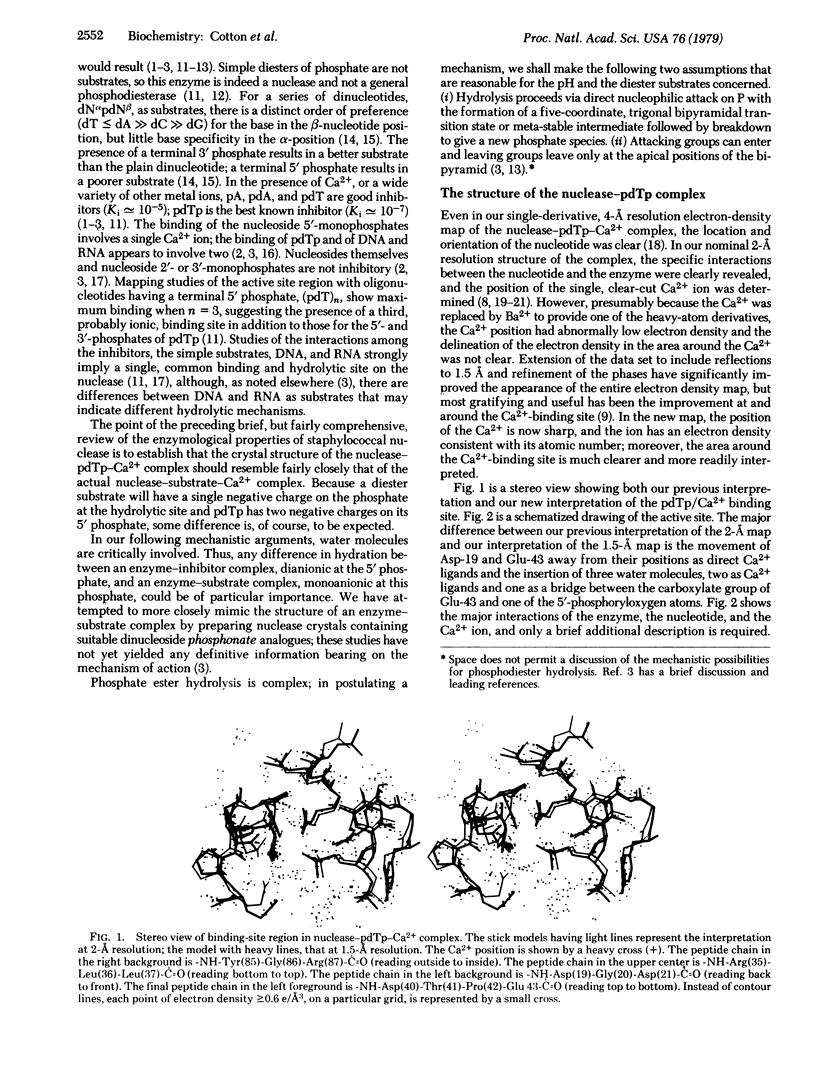
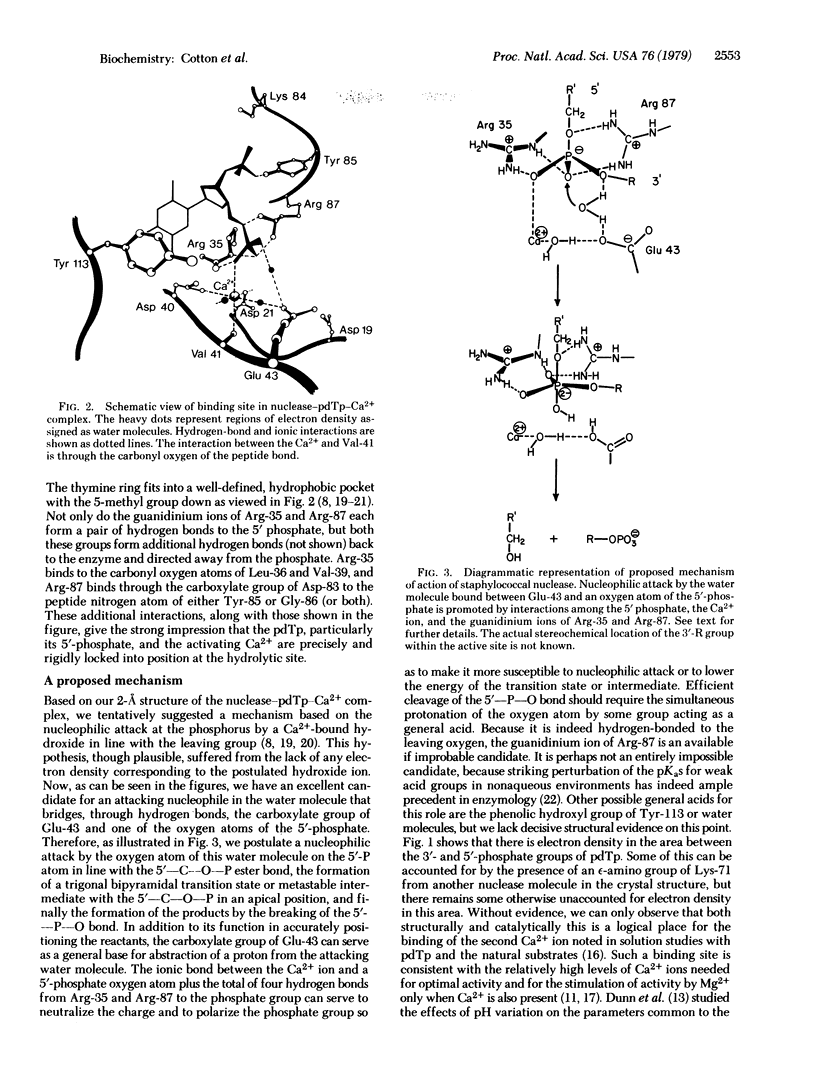
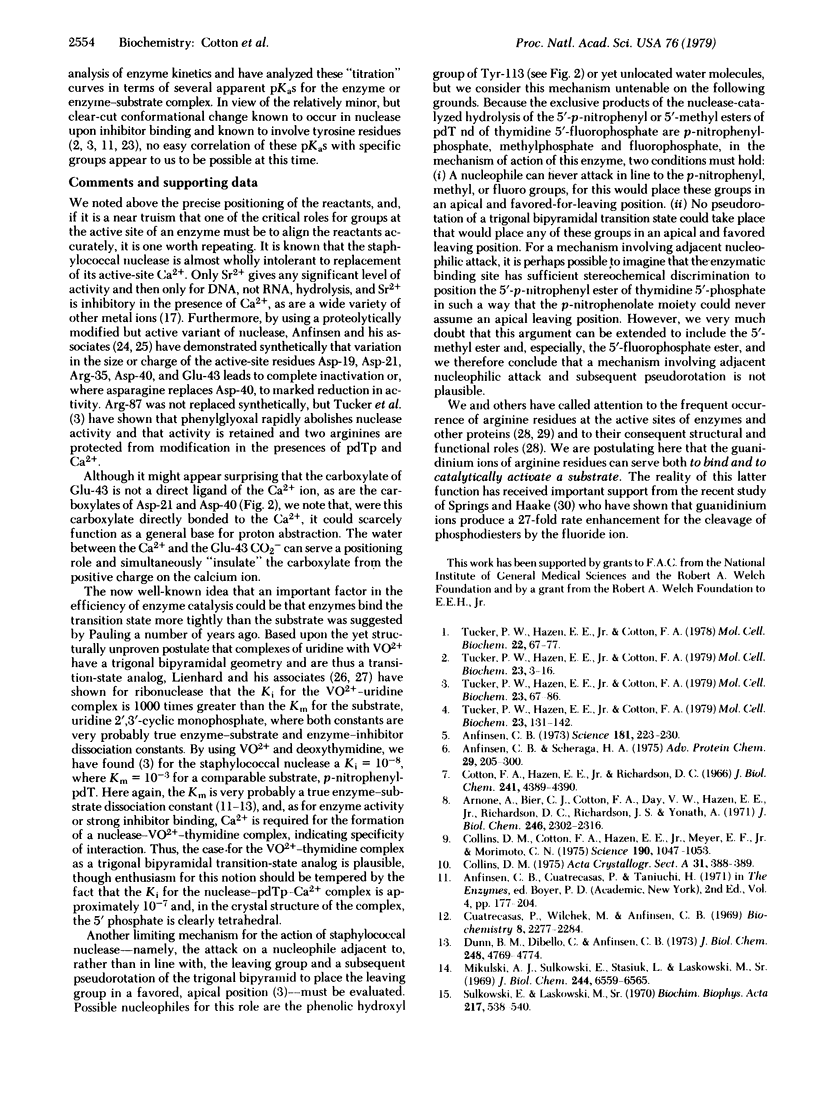
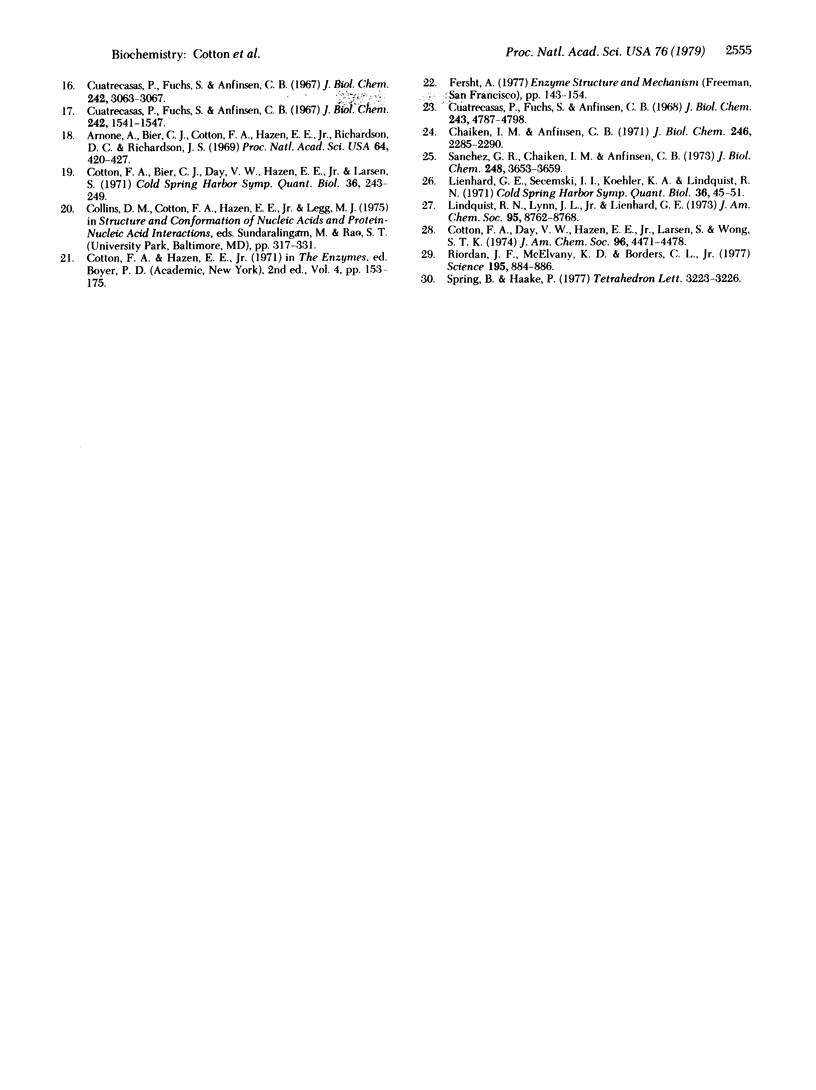
Selected References
These references are in PubMed. This may not be the complete list of references from this article.
- Anfinsen C. B., Scheraga H. A. Experimental and theoretical aspects of protein folding. Adv Protein Chem. 1975;29:205–300. doi: 10.1016/s0065-3233(08)60413-1. [DOI] [PubMed] [Google Scholar]
- Arnone A., Bier C. J., Cotton F. A., Day V. W., Hazen E. E., Jr, Richardson D. C., Yonath A., Richardson J. S. A high resolution structure of an inhibitor complex of the extracellular nuclease of Staphylococcus aureus. I. Experimental procedures and chain tracing. J Biol Chem. 1971 Apr 10;246(7):2302–2316. [PubMed] [Google Scholar]
- Arnone A., Bier C. J., Cotton F. A., Hazen E. E., Jr, Richardson D. C., Richardson J. S. The extracellular nuclease of Staphylococcus aureus: structures of the native enzyme and an enzyme-inhibitor complex at 4 A resolution. Proc Natl Acad Sci U S A. 1969 Oct;64(2):420–427. doi: 10.1073/pnas.64.2.420. [DOI] [PMC free article] [PubMed] [Google Scholar]
- Chaiken I. M., Anfinsen C. B. Solic phase synthetic study of the active site region of staphylococcal nuclease-T'. J Biol Chem. 1971 Apr 10;246(7):2285–2290. [PubMed] [Google Scholar]
- Collins D. M., Cotton F. A., Hazen E. E., Jr, Meyer E. F., Jr, Morimoto C. N. Protein crystal structures: quicker, cheaper approaches. Science. 1975 Dec 12;190(4219):1047–1053. doi: 10.1126/science.1188383. [DOI] [PubMed] [Google Scholar]
- Cotton F. A., Bier C. J., Day V. W., Hazen E. E., Jr, Larsen S. Some aspects of the structure of staphylococcal nuclease. I. Crystallographic studies. Cold Spring Harb Symp Quant Biol. 1972;36:243–249. doi: 10.1101/sqb.1972.036.01.032. [DOI] [PubMed] [Google Scholar]
- Cotton F. A., Day V. W., Hazen E. E., Jr, Larsen S., Wong S. T. Structure of bis(methylguanidinium) monohydrogen orthophosphate. A model for the arginine-phosphate interactions at the active site of staphylococcal nuclease and other phosphohydrolytic enzymes. J Am Chem Soc. 1974 Jul 10;96(14):4471–4478. doi: 10.1021/ja00821a020. [DOI] [PubMed] [Google Scholar]
- Cotton F. A., Hazen E. E., Jr, Richardson D. C. Crystalline extracellular nuclease of Staphylococcus aureus. J Biol Chem. 1966 Oct 10;241(19):4389–4390. [PubMed] [Google Scholar]
- Cuatrecasas P., Fuchs S., Anfinsen C. B. Catalytic properties and specificity of the extracellular nuclease of Staphylococcus aureus. J Biol Chem. 1967 Apr 10;242(7):1541–1547. [PubMed] [Google Scholar]
- Cuatrecasas P., Fuchs S., Anfinsen C. B. The binding of nucleotides and calcium to the extracellular nuclease of Staphylococcus aureus. Studies by gel filtration. J Biol Chem. 1967 Jul 10;242(13):3063–3067. [PubMed] [Google Scholar]
- Cuatrecasas P., Fuchs S., Anfinsen C. B. The tyrosyl residues at the active site of staphylococcal nuclease. Modifications by tetranitromethane. J Biol Chem. 1968 Sep 25;243(18):4787–4798. [PubMed] [Google Scholar]
- Cuatrecasas P., Wilchek M., Anfinsen C. B. The action of staphylococcal nuclease on synthetic substrates. Biochemistry. 1969 Jun;8(6):2277–2284. doi: 10.1021/bi00834a007. [DOI] [PubMed] [Google Scholar]
- Dunn B. M., DiBello C., Anfinsen C. B. The pH dependence of the steady state kinetic parameters for staphylococcal nuclease-catalyzed hydrolysis of deoxythymidine-3'-phosphate-5'-p-nitrophenylphosphate in H 2 O and D 2 O. J Biol Chem. 1973 Jul 10;248(13):4769–4774. [PubMed] [Google Scholar]
- Lienhard G. E., Secemski I. I., Koehler K. A., Lindquist R. N. Enzymatic catalysis and the transition state theory of reaction rates: transition state analogs. Cold Spring Harb Symp Quant Biol. 1972;36:45–51. doi: 10.1101/sqb.1972.036.01.009. [DOI] [PubMed] [Google Scholar]
- Lindquist R. N., Lynn J. L., Jr, Lienhard G. E. Possible transition-state analogs for ribonuclease. The complexes of uridine with oxovanadium(IV) ion and vanadium(V) ion. J Am Chem Soc. 1973 Dec 26;95(26):8762–8768. doi: 10.1021/ja00807a043. [DOI] [PubMed] [Google Scholar]
- Mikulski A. J., Sulkowski E., Stasiuk L., Laskowski M., Sr Susceptibility of dinucleotides bearing either 3'- or 5'-monophosphate to micrococcal nuclease. J Biol Chem. 1969 Dec 25;244(24):6559–6565. [PubMed] [Google Scholar]
- Riordan J. F., McElvany K. D., Borders C. L., Jr Arginyl residues: anion recognition sites in enzymes. Science. 1977 Mar 4;195(4281):884–886. doi: 10.1126/science.190679. [DOI] [PubMed] [Google Scholar]
- Sulkowski E., Laskowski M. S. Hydrolysis of ribo- and deoxyribo-dinucleotides by micrococcal nuclease. Biochim Biophys Acta. 1970 Oct 15;217(2):538–540. doi: 10.1016/0005-2787(70)90553-8. [DOI] [PubMed] [Google Scholar]
- Sánchez G. R., Chaiken I. M., Anfinsen C. B. Structure-function relationships at the active site of nuclease-T'. J Biol Chem. 1973 May 25;248(10):3653–3659. [PubMed] [Google Scholar]
- Tucker P. W., Hazen E. E., Jr, Cotton F. A. Staphylococcal nuclease reviewed: a prototypic study in contemporary enzymology. I. Isolation; physical and enzymatic properties. Mol Cell Biochem. 1978 Dec 22;22(2-3):67–77. doi: 10.1007/BF00496235. [DOI] [PubMed] [Google Scholar]
- Tucker P. W., Hazen E. E., Jr, Cotton F. A. Staphylococcal nuclease reviewed: a prototypic study in contemporary enzymology. II. Solution studies of the nucleotide binding site and the effects of nucleotide binding. Mol Cell Biochem. 1979 Jan 15;23(1):3–16. doi: 10.1007/BF00226675. [DOI] [PubMed] [Google Scholar]
- Tucker P. W., Hazen E. E., Jr, Cotton F. A. Staphylococcal nuclease reviewed: a prototypic study in contemporary enzymology. III. Correlation of the three-dimensional structure with the mechanisms of enzymatic action. Mol Cell Biochem. 1979 Jan 26;23(2):67–86. doi: 10.1007/BF00226229. [DOI] [PubMed] [Google Scholar]
- Tucker P. W., Hazen E. E., Jr, Cotton F. A. Staphylococcal nuclease reviewed: a prototypic study in contemporary enzymology. IV. The nuclease as a model for protein folding. Mol Cell Biochem. 1979 Feb 9;23(3):131–141. doi: 10.1007/BF00219452. [DOI] [PubMed] [Google Scholar]


